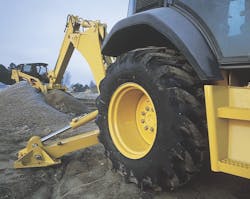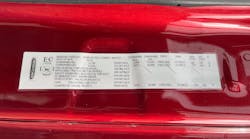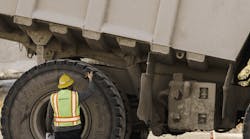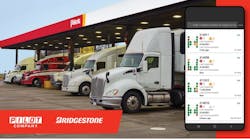Replacing tires is the second-largest operating cost for off-road fleets, behind fuel. And just like diesel, tires are considered a consumable by many fleet managers. But treating tires more like assets can improve their impact on a business’s bottom line.
Every extra day that you can get out of a tire delays the expense of replacing it. And today, we know more than ever about the factors that negatively affect tire performance and shorten equipment lifespan.
Mitigating the effects of these factors requires the same diligence commonly devoted to the vehicles and heavy equipment that tires transport. The good news: Fleet managers can take advantage of new tools, technology and best practices to help make the most of their tire investments.
Inspect and track
The core of any good maintenance program is the inspection. Every fleet manager should have a routine procedure that requires drivers, maintenance personnel or both to monitor tires for over- or underinflation, and more importantly, wear patterns and tread depth.
Measuring tread depth and gathering operating hour data from the hour meter on equipment can help you determine hours per 1/32 of an inch of tread wear. Using this data, you can project the remaining operating hours the tire has. Be sure to check the tread depth of all the tires on the vehicle, measuring in more than one location on each tire. The more information and data points you collect—and record for comparison—the more informed you’ll be in determining not only the lifespan of the tire under current conditions, but also how to extend that lifespan.
An experienced and knowledgeable tire inspector can analyze wear patterns to determine their source. Roads, loads, driving behavior and poor management of inflation pressures all can take a toll on tires. The inspector should evaluate the whole operation to better understand the root cause of any shortfalls in expected tire performance.
Inspections should begin the first day the tire is mounted and be consistently conducted at intervals until the day it’s taken out of service.
If you catch irregular wear early, the tire can often be salvaged by rotating it to another wheel position or even to another vehicle. Some examples of this are heel and toe wear, poor alignment, or irregular wear caused by the steering axle.
Other possible steps include adjusting schedules for checking tire pressure, or educating drivers about how to approach different job-site conditions.
Road hazards, as opposed to normal wear and tear, are the most common reason that off-road tires must be replaced. That means fleet managers should consult with operations to ensure that they inspect job sites and haul road conditions and utilize support equipment to help maintain the site.
Software yields insights
Large and small fleets inspect their tires at different intervals and with different tools, depending on their financial and labor resources. In too many cases, those data are simply collected and stored away without proper analysis that could reap beneficial insights.
Tire-management software helps fleet managers put that knowledge to work in improving tire performance and service life. It allows fleet managers to track the status and performance of their tires by electronically capturing and displaying information on inspections, repairs and retreading.
Six months is the minimum amount of time needed to build a thorough data history for analysis. Besides revealing the main sources of tread wear, this data mining can yield information about how to increase the longevity of a tire, lower vehicle maintenance cost, and improve operating safety.
Whether your tire-management system is electronic or manual, the key to success is consistent updating with accurate information.
Tire pressure should be checked daily for all tires or at least once a week. Equipment manufacturers typically recommend a daily walkaround, which presents opportunity to easily check pressure every day. It’s also a good idea to inspect the tires and rim components for any issues before operating the equipment.
Improper inflation pressure affects the performance and service life of a tire and strains other parts of the equipment. Additionally, if the equipment is modified with sideboards, larger bucket, chains etc., additional pressure may be required to carry the load. All of this information should be regularly reviewed with your tire dealer and/or manufacturer.
Telematics assistance
The use of telematics for tires can be extremely beneficial and efficient for larger fleets. The “black box” technology behind telematics for small and medium off-road tires transmits real-time pressure data in a way that cannot be achieved with manual inspection.
Telematics devices transmit data on vehicle use, performance and maintenance. Early warning of changed variables, such as a drop in tire pressure or a rise in temperature inside the tire, can avert possible damage and potential danger, which helps to ensure a safer working environment. With that delivery system, a maintenance manager can access this data remotely and make more informed decisions accordingly. An early warning that pressure is low or has been lost means a tire to be repaired rather than replaced, potentially saving the operation money. Proactively addressing these types of issues may reduce the chances of vehicle damage due to a rapid loss in pressure.
Choose the right tire and tire dealer
Differences in tire dimensions and construction can affect equipment uptime, not just tire performance.
Tires used on a vehicle should be the same brand, similar in diameter and materials, and the same construction type—meaning all are radials or all are bias. Dual-mated tires on an axle need to run the same revolutions per mile, otherwise the smaller tire will drag and wear out faster. As the smaller tire wears, the larger tire begins to carry more load, increasing the likelihood of early removal due to heat damage. This can result in equipment downtime and unplanned expense.
An experienced tire dealer can help a maintenance manager identify the best tires to use for the application and the correct pressure for optimum performance. They also can recommend optimal fleet-inspection schedules and help fleet managers create consistent tire maintenance best practices across job sites.
The dealer also can leverage the tire manufacturer’s sales and engineering teams to help educate drivers and maintenance staff on additional ways to maximize tire service life.
For large fleets, more than one dealer may be needed to support multiple locations. In those instances, a formal, tire-maintenance program is recommended to align procedures across the fleet’s operation.
Fleet managers can tap the knowledge and support of dealers and tire manufacturers to tailor the most efficient and cost-effective tire-management practices for their companies.
--LeBron Haggard is Manager, OTR Field Engineering, Bridgestone Commercial.





